Though its origins can be traced to the rugby field, the word Scrum has taken on a new meaning, and purpose, in today’s professional workforce. Today, Scrum serves as a framework for getting things done. In the early days, the framework was largely applied to software development, but its use has become more common in Scrum project management and other sectors, including marketing, product development, and financial services.
If you’re planning for a career in one of those fields, you may be stumped when you first hear terms such as the sprint, the Scrum Master, and the product backlog. These terms aren’t meant to confuse you; they simply apply to different aspects of the Scrum framework. Consider this article a helpful guide to understanding those terms and implementing Scrum in your workplace.
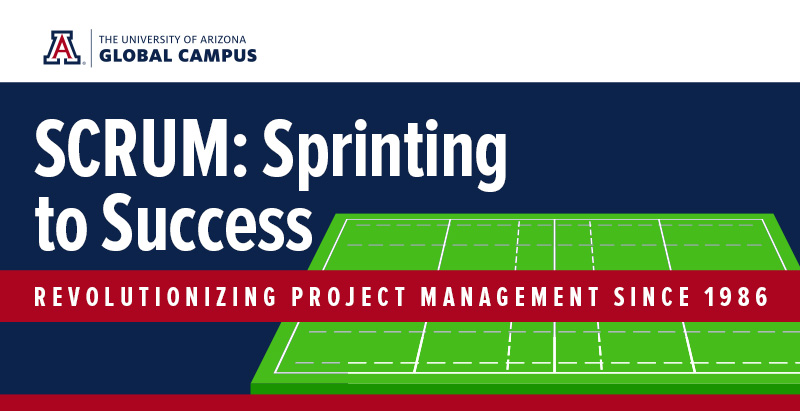
Why is it Called Scrum?
The Scrum methodology complements what is referred to as the agile approach to project management – a means of “breaking down large projects into more manageable tasks, which are completed in short iterations throughout the project life cycle.” The Scrum framework relies on constant collaboration, so teams can easily complete a task within an allotted time before moving on to the next project phase.
The group mindset and teamwork involved when players from a rugby Scrum inspired the word’s use in the modern workforce. As a framework, Scrum has its roots in the 1986 Harvard Business Review article “The New New Product Development Game” by Hirotaka Takeuchi and Ikujiro Nonaka, which advanced the idea that companies can achieve more by adopting “a holistic method – as in rugby, the ball gets passed within the team as it moves as a unit up the field.”
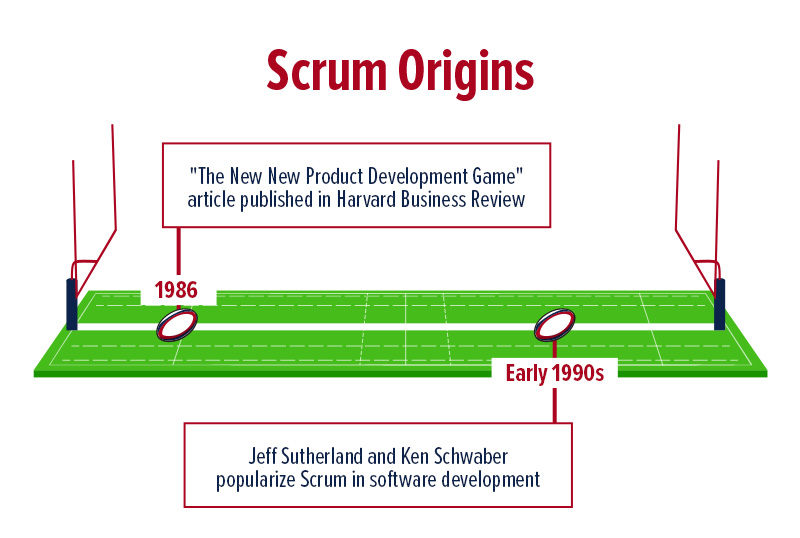
Scrum was further popularized in the early 1990s by Jeff Sutherland and Ken Schwaber, who sought to expand and apply the concept to software development. The pair have continued to update and publish their framework and ideas in the Official Scrum Guide, which can be downloaded online.
In order to employ Scrum successfully, Sutherland and Schwaber argue, those involved must adhere to five values: commitment, focus, openness, respect, and courage.
“These values give direction to the Scrum team with regard to their work, actions, and behavior,” the authors explain. “The decisions that are made, the steps taken, and the way Scrum is used should reinforce these values, not diminish or undermine them.”
When these values are embodied by the team, Sutherland and Schwaber add, the pillars, or principles of Scrum “come to life building trust.”
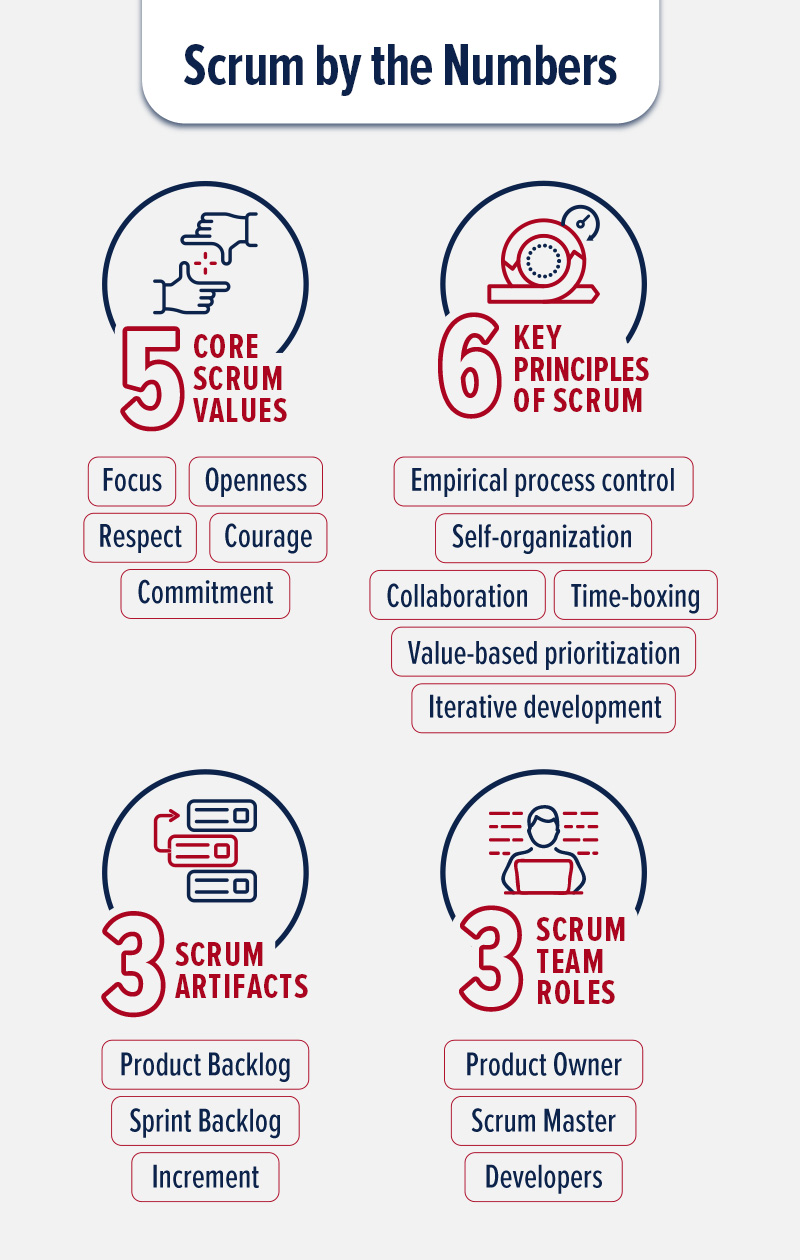
The Six Principles of Scrum
The Scrum framework relies on six basic principles, guidelines that must be followed throughout every project. Must is the keyword, as Scrum followers are adamant that each principle remains intact and adhered to, lest the team lose focus or the project suffer any setbacks.
The six principles are:
1. Control over the empirical process.
In Scrum, the empirical process is based on observation of hard evidence and experimentation rather than theory. There are three main ideas to empirical process control: transparency, inspection, and adaptation.
2. Self-organization.
As the Scrum process relies on many individuals, self-organization is essential. Everyone involved is empowered to work independently, and the self-organization principle allows for greater buy-in among all parties, while making it easier to assess individual contributions.
3. Collaboration.
Scrum is a collaborative process, as evidenced by the many roles involved (more on that below). This principle also focuses on three dimensions of collaboration: awareness, articulation, and appropriation.
4. Value-based prioritization.
This principle involves organizing and prioritizing tasks based on their value and how they need to be completed.
5. Time-boxing.
In Scrum, tasks are completed in “sprints,” with specific lengths of time assigned to each one. Other elements, including “sprint planning” and daily meetings, are also given specific start and stop times. This time-boxing ensures that all involved know how much time is allocated to each step, with the goal of eliminating wasted time and delays.
6. Iterative development.
This final principle speaks to the understanding that a project may need to be refined multiple times during the development process. Iterative development allows the team to make adjustments and manage change easier.
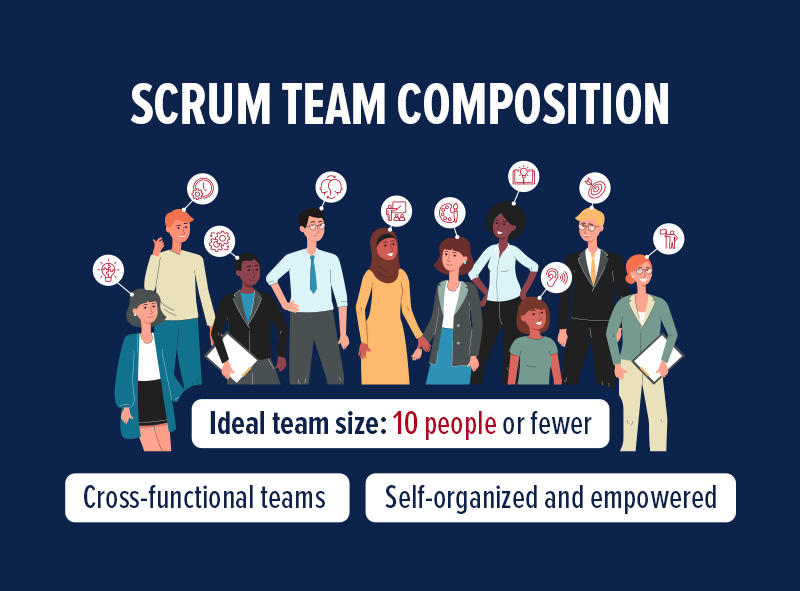
Teamwork Makes the Dream Work
To deliver any project successfully, you must rely on the contributions of the Scrum team. Members of the team don’t necessarily have to come from the same department – teams will include everyone from purchasing to marketing – but they all have to play a role in the process. The Scrum team is not built on a hierarchy; every member is treated equally in order to accomplish each objective.
The Scrum Guide recommends that Scrum teams be:
1. Cross-functional. Every team member has the skills needed to create value. They are self-organized and empowered to work independently on their individual ends to accomplish the common goal.
2. Smaller. To avoid gaps in communication and decreased productivity, Sutherland and Schwaber suggest keeping teams to 10 people or fewer. This way, the team is “nimble and large enough to complete significant work within a sprint.”
3. Accountable. “The entire Scrum team is accountable for creating a valuable, useful increment every sprint,” the authors explain. There are three specific accountabilities – three specific roles – within each team: product owner, Scrum Master, and developers.
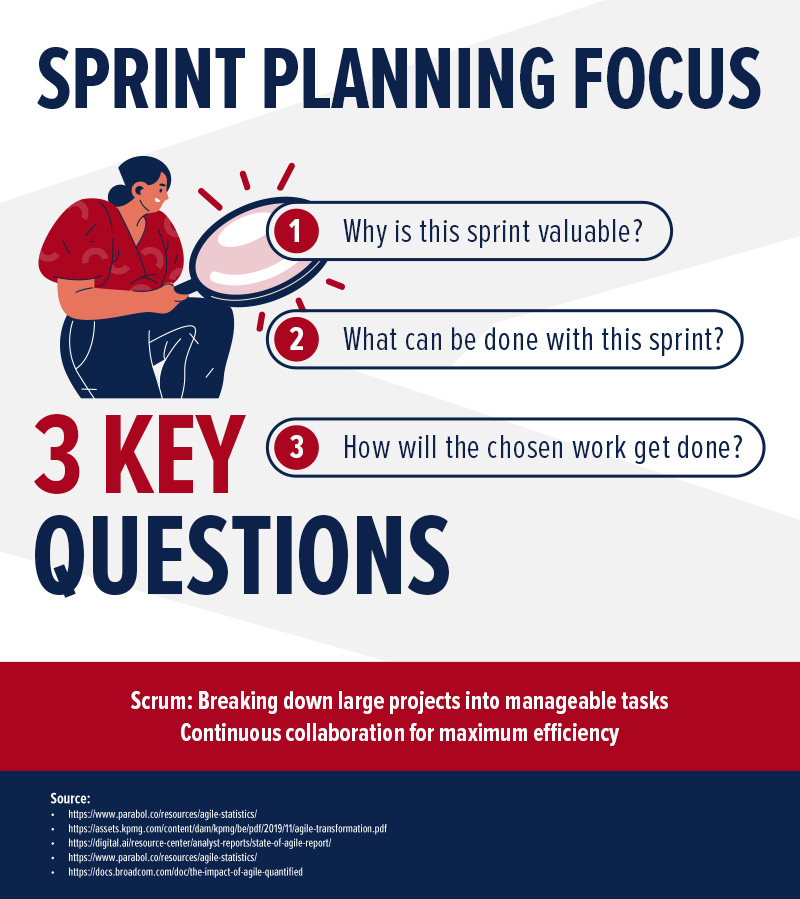
Product Owner
The product owner is, above all, the person who will have the final say on whether the project is a success, because they are the key stakeholder. A product owner will conceive an idea and/or goal and task the team with executing the vision. According to Scrum.org, the product owner is also accountable for product backlog management, a responsibility that includes:
- Developing and explicitly communicating the product goal
- Creating and clearly communicating product backlog items
- Ordering product backlog items
- Ensuring that the product backlog is transparent, visible, and understood
As project management evolves, so too will the role of product owners. To keep up, you can complete a professional Scrum Product Owner certification, a number of which can easily be found via online search. Some of this training may be included in a larger Agile Project Management certification, such as the one offered by the Project Management Institute.

Scrum Master
While the product owner is often the originator, most team members look to the Scrum Master for direction. It falls on the Scrum Master to keep the team on time and on-task, remove obstacles to progress, and facilitate communication between the product owner and the development team.
According to the Scrum Guide, a Scrum Master must foster an environment where:
1. A product owner orders the work for a complex problem into a product backlog
2. The Scrum team turns a selection of the work into an increment of value during a sprint
3. The Scrum team and its stakeholders inspect the results and adjust for the next sprint
Then repeat.
Adherence to agile principles, processes, and practices is at the core of the Scrum Master’s mission, and, as Scrum.org points out, the Scrum Master serves the organization and the product owner as it serves the development team, by:
- Helping find techniques for effective product goal definition and product backlog management
- Leading, training, and coaching the organization in its Scrum adoption
- Planning and advising Scrum implementations within the organization
- Helping employees and stakeholders understand and enact an empirical approach for complex work
The path to becoming a Scrum Master is not an easy one. For example, the Project Management Institute requires a bachelor’s degree and several months of project management experience before certification. There are some certifications offered online that don’t require a degree as a prerequisite, but you should weigh the pros and cons of each before making a final determination.
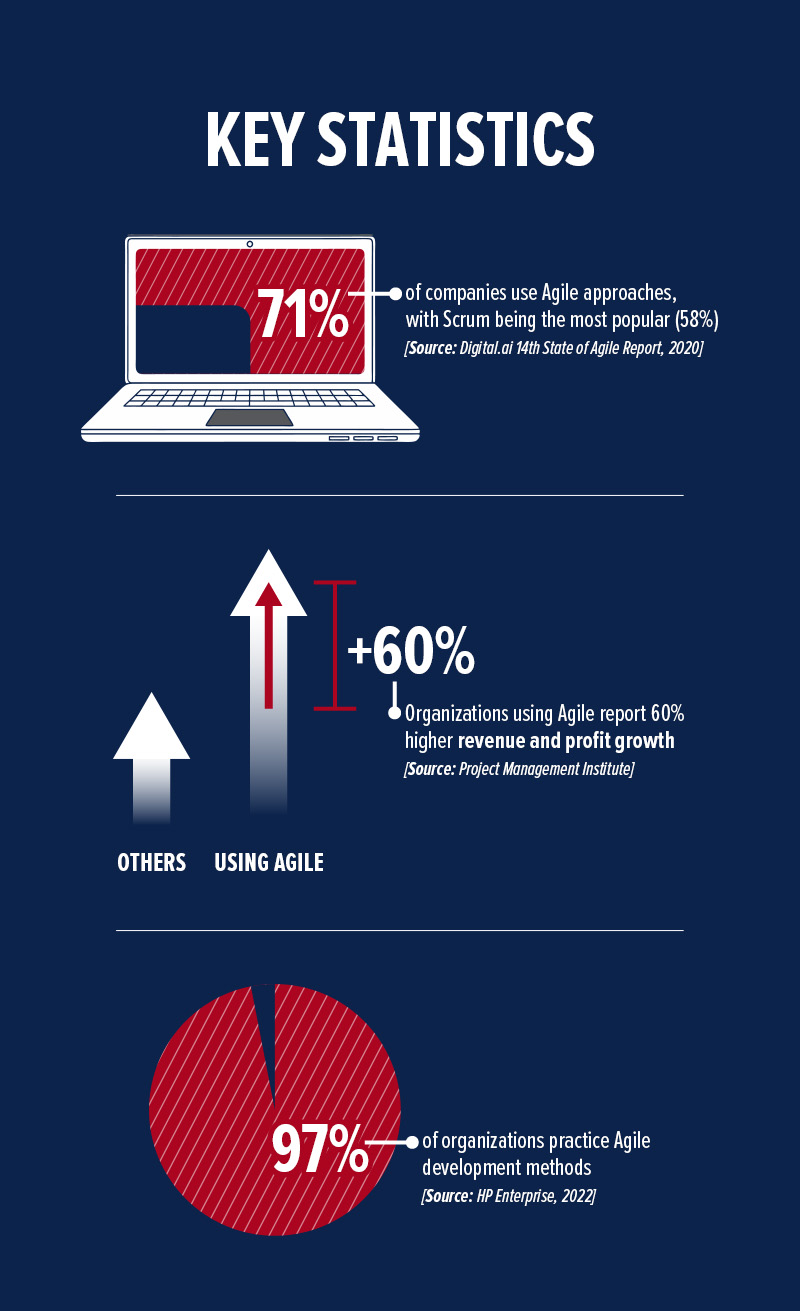
Developers
When it’s time to execute the sprint, the product owner and Scrum Master turn to the development team. The teams – which do not have to be large or small – will be made up of several individuals who are responsible for executing the vision as laid out by the product owner, under the direction of the Scrum Master.
The development team will consist of individuals with specialized skills, each one assigned to a different task. For example, say you need to prepare an advertorial for your brand. Your development team may include the following:
- Copywriter to create content
- Graphic artist to create images
- Creative director to conceive and approve the overall design of the advertorial
Throughout the creative process, the Scrum Master will keep everyone on-task and ensure deadlines are met and the finished project will be delivered to the product owner for approval.
You can learn more about the role of the development team in a project management degree program. You can also earn Scrum Developer assessments offered by Scrum.org that largely apply to professionals in software development.
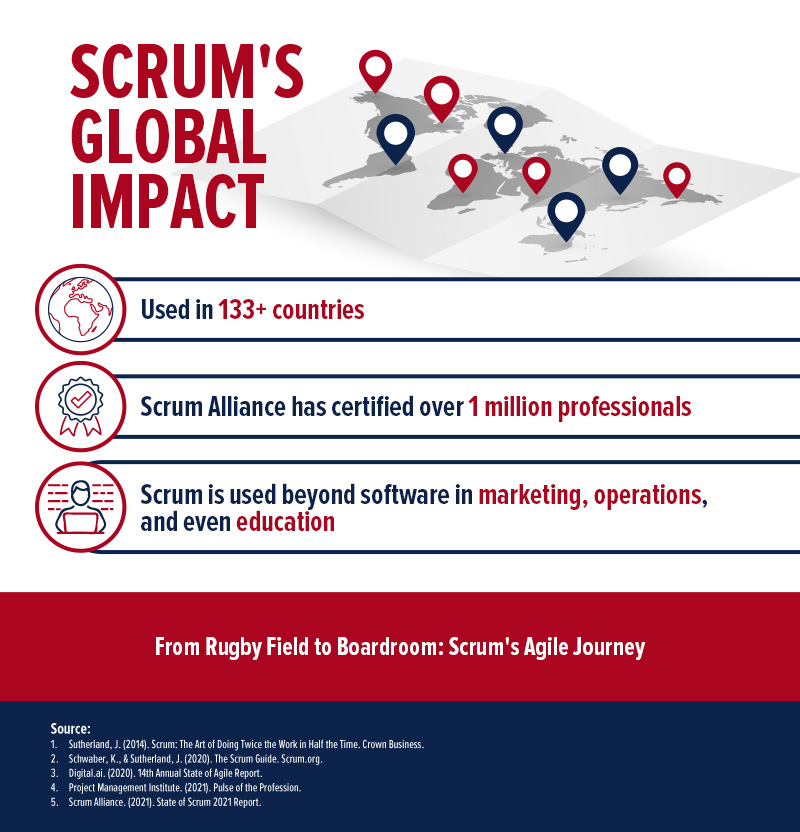
The Scrum Process and Terminology
Scrum is a carefully managed process, with the framework consisting of various “sprints” to the finish line. If you are applying Scrum in your workplace, you will become very familiar with the cycle and each of its components.
What are the Three Scrum Artifacts?
In Scrum, the word “artifacts” is not used in the traditional sense – so, you can forget about Indiana Jones and archaeology. Rather, artifacts are pieces of information and tools that keep the project on-track: the product backlog, the sprint backlog, and the product increment.
Product Backlog
The product backlog acts as a to-do list for those involved, with a roadmap and requirements that are organized and prioritized by the product owner, with the long-term objective defined as the product goal. The product backlog is continuously updated throughout the project lifecycle as new information comes in, achievements are made, and obstacles are overcome. Many of those updates will come from the development team and stakeholders, and changes to the product backlog must be communicated to the team in order to keep everyone on the same page.
Sprint Backlog
The sprint backlog is formed when developers select items directly from the product backlog itself – items that represent the most important task to be completed during the next sprint. This is done on a sprint-by-sprint basis, as priorities often change during the process and the product backlog is updated. A successful sprint backlog will allow everyone to see which task is being worked on, and by whom, and will reinforce the shared sprint goal – the outcome for the sprint.
Increments
The Scrum Guide defines an increment as “a concrete steppingstone toward the product goal. Each increment is additive to all prior increments and thoroughly verified, ensuring that all increments work together.”
According to the Scrum Guide, each of the three artifacts contains a commitment that is used to measure success:
1. Product Backlog <---> Product Goal
2. Sprint Backlog <---> Sprint Goal
3. Increment <---> Definition of Done (see below)
What is the Sprint Cycle?
A sprint is simply the timeframe that a team is given to complete a specific job. One sprint does not mean taking a project from conception to completion, but rather the completion of a specific phase in the project lifecycle. A successful sprint, according to the Scrum Guide, means:
- No changes are made that would endanger the sprint goal
- Quality remains consistent and does not decrease
- The product backlog is refined as needed
- The scope of a project may be clarified and renegotiated as more is learned
The Sprint itself is broken down into several components, each one recurring within the sprint cycle:
Sprint Planning
As the name suggests, sprint planning is a meeting in which the team determines how it will approach the next sprint. As each component of the project is finished, sprint planning evolves, so the agenda and deadlines may evolve as well. The goal of sprint planning is to ensure that everyone is motivated and understands what’s required in the next sprint.
According to the Scrum Guide, a successful sprint will address three topics:
1. Why is this sprint valuable?
2. What can be done this sprint?
3. How will the chosen work get done?
Daily Scrum
Daily Scrum meetings serve as temperature checks throughout the sprint. This is a chance for each team member to provide an update on their progress and determine what they need moving forward. The Daily Scrum is overseen by the Scrum Master (more on Scrum roles below) and is held at the same time and place – for 15 minutes – every day during the sprint. The 15-minute timeframe allows for all involved to focus solely on the sprint without getting distracted by other issues.
Sprint Review
Upon completion of each sprint, the sprint review serves as an autopsy before moving on to the next sprint – one that is solely focused on the product. Dan Radigan, Principle Technical Account Manager at Atlassian and writer for the “Agile Coach,” suggests that sprint review take place in an informal setting, and can yield positive results when those involved follow three steps:
1. Define “done.” “A clear definition of ‘done’ helps teams focus on the end goal for each work item,” Radigan writes.
2. Celebrate the team. The sprint review should give each person involved a chance to showcase what they’ve accomplished and learned during the sprint. This gives each person a chance to be recognized for their contribution.
3. Reach across geographies. When you have a team working remotely or in faraway offices on the other side of the world, you need to maintain a connection in order to create harmony. Radigan suggests creating informal videos that can be shared online to keep everyone up-to-date on the progress of the project.
Sprint Retrospective
While the sprint review is about the product, the Sprint Retrospective is about the team. Taking place before the next sprint planning session, the purpose of the retrospective is to:
- Discuss the outcome of the recent sprint and identify ways it was successful or unsuccessful in relation to your team members
- Determine what improvements could be made to increase efficiencies, eliminate redundancies, make improvements, and develop harmony within the team
- Apply the lessons learned in the previous sprint to the team’s workflow moving forward
In a fast-moving workplace in which multiple teams are often balancing multiple projects, Scrum serves as a framework for maintaining communication, consistency, and quality while delivering a product on time.
However, it is important to note that Scrum is just one component within the project management umbrella, and a holistic understanding of the discipline is essential to your success, whether you are beginning your college career or returning to school to update your skill set. If you are looking to succeed in this in-demand field or considering the benefits of a degree vs. a certification*, reach out to an advisor today.
Scrum: Infographics


--
